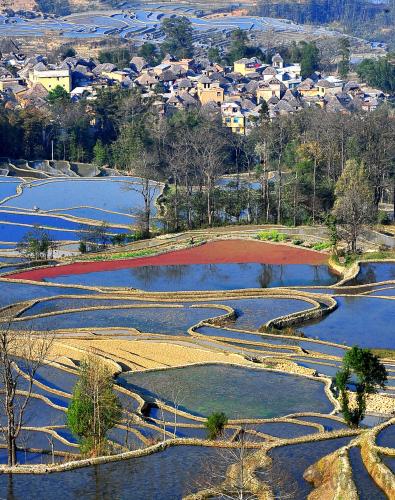|
 |
|
HARMONIOUS COUNTRYSIDE: The Hani villages are located near rice terraces (CHEN HAINING) |
Moreover, the resilient land management system of the rice terraces demonstrates extraordinary harmony between people and their environment, both visually and ecologically, based on exceptional and long-standing social and religious structures, according to the World Heritage Committee.
In agricultural production, local farmers believe all natural things are gifts from Mother Earth. Self-sufficient natural economy is the core of the local traditional lifestyle. They try not to use any industrial products, such as chemical fertilizers and tractors.
For example, from late April to late September, Hani people grow red rice, the terrace's dominant crop. They use cattle and buffalo to plow the terraces. Fish and ducks are also bred in the paddies, which improves fertility while providing food for people and animals. The water from springs and rain is collected by the forests and distributed to the fields through a system of ditches, canals and bamboo pipes.
The Hani people also like to use readily available local materials to build houses. Their settlements are comprised of "mushroom houses," built of rammed earth, adobe bricks and stone with umbrella-shaped straw-thatched roofs.
Typically, the houses have three stories. The first is for livestock; the second is the living area and the top floor is for grain storage, integrating the functions of dwelling and agriculture.
Preservation efforts
"It is important for us to better preserve and protect this cultural landscape," said Yang Fusheng, Governor of Honghe Hani and Yi Autonomous Prefecture at a celebration meeting in Yuanyang County on June 22.
"We have learned much from the experience of Hani rice terrace preservation efforts over the past 10 years. And we will continue to improve our work in line with the World Heritage Convention in the future," Yang said.
In a bid to protect the world wonder, the local government and people have taken a well-rounded and substantial approach.
For example, the local government is working with Tsinghua University's School of Architecture to develop guidelines for maintaining the mushroom houses' exterior characteristics with improved interior functions.
As for the upcoming boom of tourism development, the local government has made plans to cope with new challenges. For instance, the government offers farmers subsidies to encourage them to continue cultivating the paddies. Otherwise, it is feared nearly all locals might abandon them to work in the tourism industry. And starting from October, only electric vehicles will be allowed to drive in the heritage area.
"The World Heritage Committee's designation of Hani terraces will boost the local tourism industry. But we will never develop conventional sightseeing-type tourism that relies on large numbers of visitors flocking to the scenic area," the prefecture's deputy governor Tan Ping said at a meeting in Beijing with experts of heritage protection on June 24.
Wang Lijun, Deputy Director of the Architectural History Department at China Architecture Design and Research Group, suggested that the prefecture impose necessary restrictions on visitors entering the heritage area.
It is expected that tourists coming to Yuanyang County will increase by three times as the cultural landscape is inscribed on world heritage list. In following years, that figure may reach 1.5 million visits a year.
"Tourists flocking to villages and farmlands will have an impact on the local ecological system," Wang said.
Restrictions alone are not enough. Wang suggested the local government lay emphasis on improving the infrastructure of villages and towns, and establish a management system to provide convenient services for visitors. In that way, tourists can experience traditional country life and enjoy relaxation without trampling the precious environment.
Lu Zhengkang, a 43-year-old Hani villager, opened a family inn years ago. Recently, Lu's income has spiked as the Hani terraces have attracted more visitors.
Addressing fears of a decline in rice paddy cultivation, Lu said, "Planting rice in terraces is the precious tradition of the Hani people. No matter how rich we are, we will not abandon the land we inherited from our ancestors. Otherwise, it would bring shame to the family."
Email us at: baishi@bjreview.com | 